Reading to Dogs Programs
Reading ability has a significant impact on all areas of academic learning. Poor reading skills at an early age can lead to lower self-esteem, underachievement, a dislike of school and an increased risk of dropping out.
Students who struggle with reading benefit from individual reading instruction and extra reading time. (see sources below)
While researching our new “Dogs Make A Difference” TV Episode, we met some amazing Therapy Dogs who work in schools, libraries, bookstores and hospitals helping children. Our research showed, one way to encourage students to read more and improve their skills and confidence, is the introduction of therapy dogs as part of a reading program.
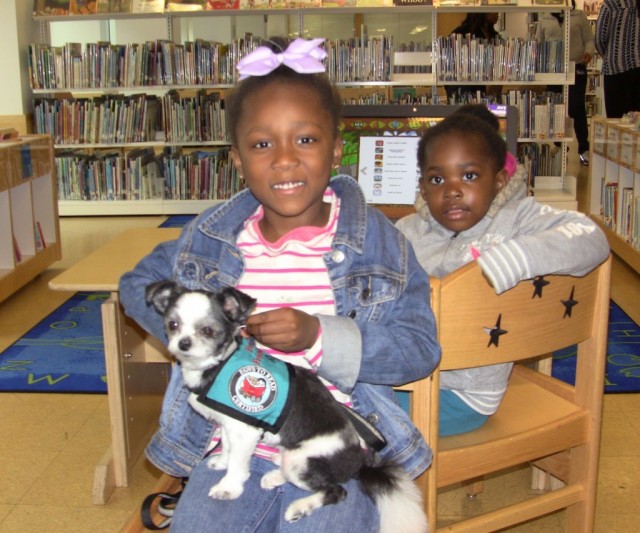
Health and psychological studies indicate the benefits of contact with animals, particularly for children. They can provide children with a relaxed and non judgemental atmosphere where they can feel comfortable learning. As Dr Stanley Coren states in our documentary, and Karen Allen explains in the Journal of Personality and Social Psychology, animals, particularly dogs, can cause reductions in blood pressure and stress hormones for humans, and even a release of hormones that reduce anxiety. One study measured the physiological stress response of a participant asked to complete a task alone, then again with a friend present, and finally with their dog. Results showed the highest level of stress among participants was exhibited when their friend was present. The lowest level of stress was with their dog present. Allen’s explanation for these results is that the participants considered other people, as an evaluative presence while the dog is a non-evaluative presence, simply providing support and comfort without judging them. Another study found that pre-adolescents who had a pet had higher autonomy, self-concept and self-esteem. All qualities considered important for academic success. In addition, results from this study also suggested that pets can be considered as a source of support.(see source below **)
The human-animal bond created during the Therapy Dog reading sessions seems to build confidence, while providing a support system needed to practise and improve cognitive learning. As researchers Barker and Wolen state in their review of The Benefits of Human-Companion Animal Interaction for the Journal of Veterinary Medical Education , there have been numerous studies related to the effects of therapy or service animals on children with disabilities and autism, including increased use of language and social interactions while with the animal. Children in the presence of animals demonstrated a greater sustained focus and had a higher state of awareness, positively effecting attitudes toward school.
One of our interview subjects was Marie, handler of gorgeous celebrity and Therapy Dog Bocker the Labradoodle. They participate in the Tail Waggin’ Tutors Program, part of Therapy Dogs International. Children love reading to Bocker. Bocker certainly made me, and everyone he met that day smile.
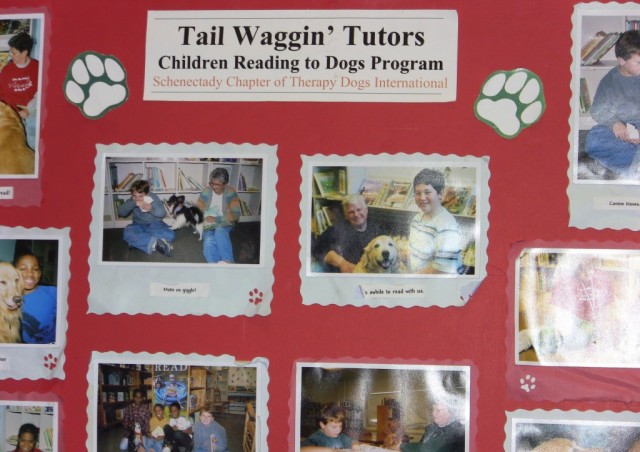
The main objective of the Tail Waggin’ Tutors Program program is to provide a relaxed and “dog-friendly” atmosphere, which allows students to practice the skill of reading. Many of the children chosen for this program have difficulties reading and as a result, have developed self-esteem issues. They are often self-conscious when reading aloud in front of other classmates.
By sitting down next to a dog and reading to the dog, all threats of being judged are put aside. The child relaxes, pats the attentive dog, and focuses on the reading. Reading improves because the child is practicing the skill of reading, building self-esteem, and associating reading with something pleasant – one school said “children flourished, with reading scores going up”. Bocker also works with children with disabilities, or illnesses and they certainly appear to make great progress and enjoy his visits.
We also met the Therapy Pugs, Sailor and Scarlett (Allan’s Angels) who work in the Reading Education Assistance Dogs (R.E.A.D.) program which was created by a non-profit organization that encourages children to read through the use of well trained therapy animals.
Researchers at Tufts University Cummings School of Veterinary Medicine conducted a study with elementary school children to test the effectiveness of these types of programs. Each child was asked to read three different 150 word passages for one minute each. Resarchers then noted how many words the child got correct per minute (WCPM) then the median score was used as the child’s CBM score. They were then given the Elementary Reading Attitude Survey (ERAS) to assess the child’s attitude toward reading in both academic and recreational settings. The results from the study confirm the positive effect therapy animals have on humans. The findings suggest the “R.E.A.D. program may not only affect the reading ability of children during the program, but may make them more receptive to reading programs in a school setting.”
“We love to go to schools, libraries, hospitals and other places to spread pug love” – Therapy Pugs
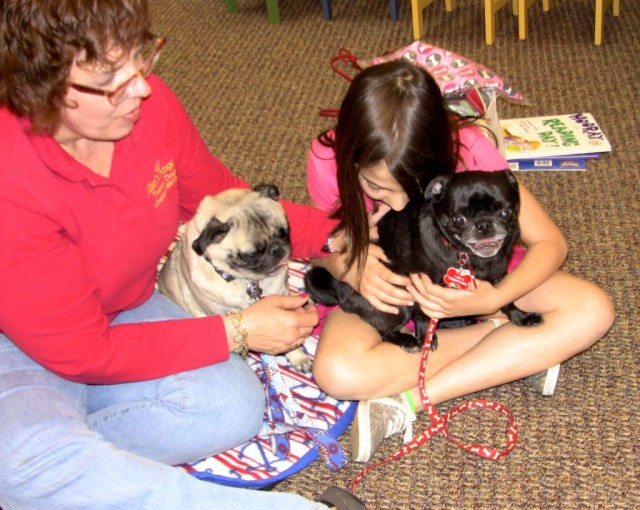
Denise, the pugs handler, explained to us the importance of a therapy dog choosing their line of work. Both Sailor and Scarlett love working with children, so she decided to get involved with R.E.A.D.
“It’s been realized that dogs have such a calming influence on people in homes and hospitals. The program has really taken off and has shown that children reading to dogs increased their reading skills, increased their test scores, increased their participation in school events – because dogs don’t judge” Denise, a nurse, explains further that “just by petting a dog a child’s heart rate and blood pressure goes down. The dogs love it, and I love it!” As a self proclaimed bookworm and dog lover, she says the reading sessions are incredibly inspiring, rewarding and fun for both her, the dogs and the children. The pugs not only visit younger school children but also make special trips to local universities and colleges during mid terms and finals, to help students take a much needed stress break. The pugs sometimes nod off and snore like they are hearing a bed time story.. which is so adorable- the kids love that!
Gizmo the Wonderdoglet, a Paws for Friendship certified therapy dog is also a Paws to Read certified animal assisted reading dog.

He visits local schools and libraries like the fabulous Hartford Public Library to encourage young visitors to practice their reading. These readers can feel relaxed reading at their own pace to a patient and willing listener. Gizmo loves to snuggle on laps while being read too. Handler Jennifer explained that Gizmos calm energy seems to transfer to the children making them calm and collected as they read.
One of the biggest highlights for reading assistance dogs is their non judgemental passive company they offer the child. As Gizmo’s handler pointed out the dogs will never scold or embarrass a child for making a mistake. They don’t know or care if a word or sound is wrong. They are simply there to enjoy the reading and company while offering an attentive ear.
Gizmo is nominated for a 2014 Hero Award and we think he is a Hero.
Gizmo’s online girlfriend Zoe the Therapy Dog a certified therapy dog with Therapy Dogs Inc. She also works with children on improving their reading abilities.
sources:
*Ecklund, B.K. and Lamon, K.M. 2008. Improving reading achievement through increased motivation, specific skill enhancement, and practice time for elementary students. Education Resources Information Center, 1-105 and Wilfong, L.G. 2008. Building fluency, word-recognition ability, and confidence in struggling readers: The Poetry Academy. The Reading Teacher, 62(1), 4-13.
**Van Hautte, B.A. and Jarvis, P.A. 1995. The role of pets in preadolescent psychosocial development. J Appl Dev Psychol, 16(3), 63-479.


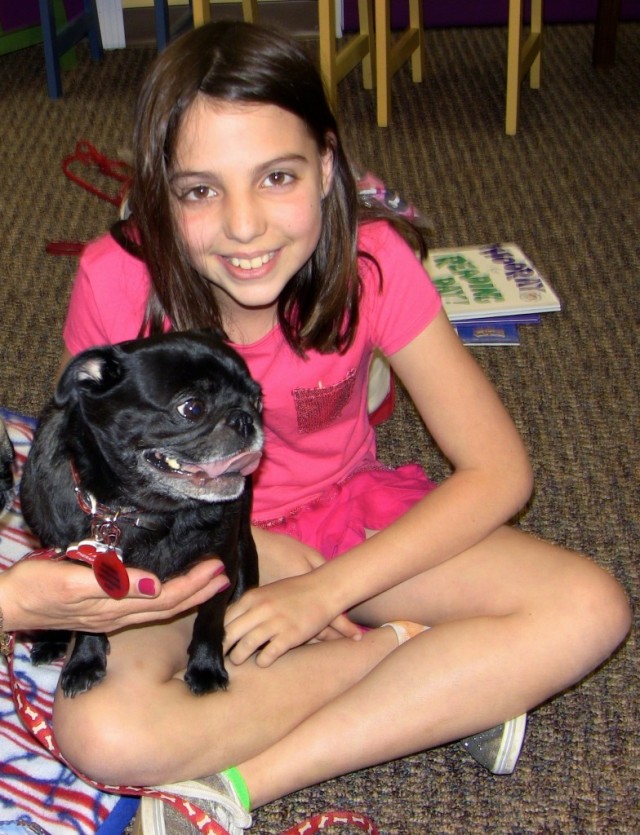
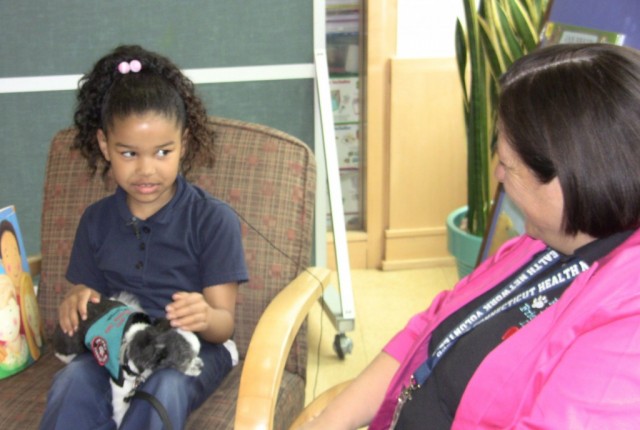

Sadly, I don’t have the transportation to make this a reality, but I’ve always thought both my dogs would do well with this kind of work. Katy loves books and Bailey just loves people.
PAWsome. Sugar as a therapy dog visits libraries (mostly in the Fall). Great to see happy smiles from the kids. Happy Wednesday. Golden Woofs
Happy Wednesday – Sugar would make me smile and relax. Such a lovely gentle friendly face with big eyes- I bet kids love Sugar. Thanks!!
I love these programs. I have several friends with dogs who are also teachers and they swear by the power of kids reading to dogs. While not part of an official group, Huxley has helped his junior handler with her speech therapy homework… and she improved faster than before she had him listening.
I saw this program on the news not too long ago. What an incredible idea and a great way for kids to relax and enjoy a love of reading.
How neat. I thought about trying this with Mr. N but he would start squirming instead of listening. He likes doing active things.
Yes – I don’t think some active sporty dogs enjoy it as much- but Mr N is certainly so cute. I saw one very active Therapy dog that goes around visiting hospitals doing fun tricks and getting patted.
These are such wonderful programs! I truly can see how the dogs can help the children to relax and learn better.
I know- dogs are amazing aren’t they! So positive.
Aww that was great! Thank you for sharing!
ღ husky hugz ღ frum our pack at Love is being owned by a husky!
Ooh, I have several friends who are Reading Assistance therapy dogs. I think it is a wonderful thing to do…but sadly, this terrier would not be good at it. Ma was a nurse (a long time ago) and she hopes one day to get a dog and train it to do therapy work. Great post!
Happy Wednesday.
Oz
Thanks so much. Yes Therapy dogs seem to switch on and off the energy and love sitting still/snoozing with kids. Not everyone is suited, but Oz is certainly cute enough LOL – I love “see the beautiful all around me”. X TH
Reading programs provide such a great service for children who are struggling with grammar and comprehension. The dogs don’t judge the kids and help them relax so they can become better readers. I think the dogs love these programs too. My rescue started an after school reading program called Tales to Tails and we’ve had very good results. Kids are tested before and after the program and all have dramatically increased their reading skills. Nice story.
I love these programs. I had a dog who would have been *perfect* for it (kids gravitated to him, super calm, zen dog), but he got sick on the very day I started my training for Therapy Dog and he passed 3 days later. My current dogs aren’t suited to therapy work at all (I tried!), hopefully in the future I will find a well suited dog. Nice article!
A great idea! I read something similar recently where kids were going into animal shelters and reading to cats as part of a socialisation program for the cats.
Dogs are so awesome! I’d love to have a therapy dog some day – my current pup is too afraid of things, and the last one passed away very young. 🙁 The one before that would never have passed the food tests I hear they make them do! She was a beagle and a total chowhound!
Hey Talenthounds, that was a great post. Harley & Leo are now Therapy Dogs and we’re all ready to get started with the Tail Wagging Tutor program. Hope to work with some library summer programs while schools are closed for summer vacation. I believe in this so much, I can’t wait to share the Boys… Thanks
Great program-we hope to get involved in something like this to help kids learn to read and gain confidence.
We have a group of dogs that come to our library. I think it’s a wonderful program. The kids seem to really enjoy reading to the dogs and hanging out with them for a bit.